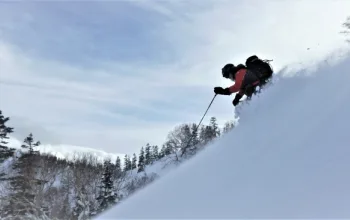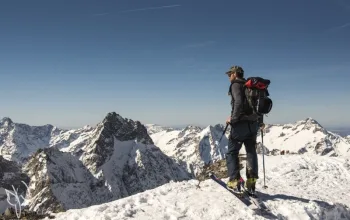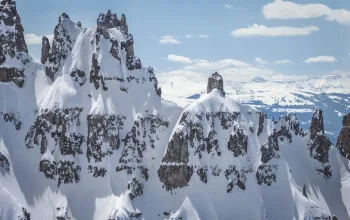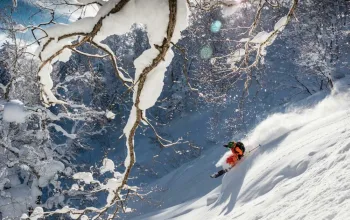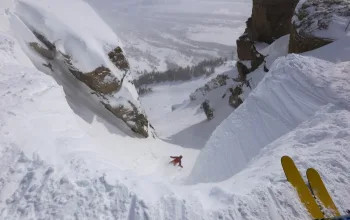Slashing a heel-side turn in fresh powder, I’m forced to make an abrupt stop. It’s not that I’ve reached the end of a piste, or that the late spring-time powder has simply melted into a green alpine meadow – it’s far more serious than that. It’s the Arctic Ocean that’s blocking my progress, its crashing, almost inky black waters beating against the ruggedly beautiful shoreline I now stand high above.
There’s a chilling gale lifting the white horses from the wave tops into the air, before depositing them as the onshore spray that I feel on my face, and the cold, sea-filled air bites deep into my freezing, exposed cheeks. But I don’t notice the cold, or even the snarling sea; it’s the sky that has my attention. A blaze of hell fire reds and deep Mediterranean blues are igniting the rolling clouds around me, as the sun skims the sea, on its long, lazy journey along the far western horizon, before finally setting around midnight.
Grounded!
Even getting to Northern Iceland’s Troll Peninsula, where Bergmenn Mountain Guides runs its unique ski touring programmes has been epic. I’m travelling with Zak, a friend and photographer, and our internal flight from Reykjavik to Akureyri has been cancelled due to high wind. In fact, according to a smiling young check-in attendant at Reykjavik domestic airport, lots of people on an earlier flight were in tears. Unsure as to whether these were tears of joy or fear, and hearing about snowdrifts on the road, we decide to skip the replacement six-hour coach ride and get a bed in a hostel until morning.
While the morning is crisp and blue, the high winds still linger, hindering all flying. A snap decision is needed, and on meeting an American couple, like us carrying snowboard bags and heading for Bergmenn’s operation too, we pool resources and take to the road in a hired 4x4.

Leaving the civilisation of Reykjavik behind and driving the coastal road, past vast areas of undulating ancient lava flow, the stark harshness of south western Iceland soon becomes apparent – a harshness broken only by isolated red farmhouses, constructed not to conquer or dominate the landscape, nor even fit in with it, but more simply, just to beg an allowance to stay.
Five hours of trouble-free driving later, we arrive in Iceland’s second city of Akureyri, where to keep the residents happy in the depths of winter, all the red traffic signals are heart shaped.
Here we meet our guide Owen, a Canadian. A further 45-minute transfer, during which we drive through a near three-mile long single-track tunnel, we finally reach the tiny fishing village of Ólafsfjörður. Sitting at a narrowing of a fjord, Ólafsfjörður was built for the herring industry of the early 20th century – but it’s also surrounded by some of Iceland’s best ski touring.
It’s 5 o’clock and the hotel restaurant is prepping for dinner, yet with a smile the staff greet us and rush off to the kitchen, returning with a hearty soup and fresh bread.
“Okay, grab some soup; dump your bags, and let’s get out there!” shouts Owen.
As we exit the van to start our first tour, I glance at my watch. I smile when I see that it’s 6pm and yet still as bright as midday. It’s wonderful not to be constrained by the hours of the sun, knowing that if your legs can still cope with the climbs, a lack of daylight won’t stop you.
As I stick the skins to the bottom of my splitboard, the strong smell of the sea fills my nostrils. Huge black backed gulls circle nearby, swooping down to steal air-drying fish heads laid out on a small patch of snow-flattened grey grass. We’re later told these are used to create a protein substitute for the third world.
We climb slowly and steadily above a snow filled gully, buffeted but not beaten by the still strong wind. It would have been nice to climb up through the sheltered gully but apparently this is a terrain trap, and even though the snow is well consolidated and the avalanche risk low, it’s still best not to push your luck.

Some two and a half hours later, after a series of false summits, we regroup just below a ridge line. There’s a small amount of spindrift whipping over the ridge towards us, indicating a strong wind, but it doesn’t look too bad, so we push on to the summit.
Once there my hat nearly leaves my head and my eyes start to water, even behind a pair of sunglasses, as the incredibly strong wind almost pushes me back down the mountainside. I stand firm, leaning into it, as I survey my surroundings. Far below the rough sea is pounding the shore on three sides, and on the fourth is an endless series of snow covered mountains, calling out to be ridden.
Dropping a short way back down the leeward side of the mountain to escape the worst of the wind, I struggle to convert my splitboard back into its snowboard form. I take off my main gloves, and wearing only a thin woollen inner, my hands soon start to lose all sensation as I fiddle to take the skins off and reattach my bindings. There is no room for a mistake, as the snow around me is firm and steep, the wind strong, and if I drop anything now it will be gone in an instant. Not wishing to be stranded at the top of a large mountain without a functioning snowboard, I work slowly and methodically, removing only one piece of kit at a time, either attaching it to my backpack or fixing it into the correct place on my slowly evolving snowboard.
Re-donning my warm gloves, I clip my feet into my board and set off down the firm spring snow. The effort of the climb is rewarded with the thrill of speeding through a couple of steep, rock-sided chutes and onto a wide open face. Here the slope is windblown but holds an edge well and allows for some sweeping carves. Far too soon we’re climbing back into the van, and although I’m tempted to head back up, a check of my watch shows it’s 9.30pm, so we head back to the hotel for a very late dinner.
Summer snow
Waking up the following morning to Iceland’s official ‘First day of Summer’, a public holiday held the first Thursday after 18 April, I head through a deep snowdrift from my wooden cabin to the hotel proper.
Huge snowflakes blow horizontally past the large dining room window as Owen explains, “There’s no need to rush this morning; it’s one of the joys of touring in Iceland this time of year. We’ll leave around 10.00ish, and I’ll make a call on where to head then.”
As I sip my third cup of coffee, the snow stops speeding by and starts to fall, ever so slowly, vertically.
“Wow! Now we’re talking!” enthuses Owen, “That’s like Japanese snow; let’s hope the wind holds off.”
Jumping in the van, we drive a short distance to the wonderfully located Bergmenn Lodge, which sits on the water’s edge of Eyjafjörður . Direct from the lodge, we skin along a wide valley floor, surrounded by an endless choice of perfectly angled slopes to choose from.

“You can stay in the lodge and explore this valley all week, without ever having to ski the same route twice. We never do it, as guests always like to see different parts of the peninsula, but lots of these slopes have never been skied. A French guy was here last week and made a first decent of that couloir,” explains Owen, as he gestures with his ski pole at a thin band of snow that clings to a mountain between two lines of jagged rocks.
The wind is being kind to us and after a long series of switchback turns, we summit a pyramid shaped mountain before taking a well-earned rest. We eat lunch with a spectacular view across Eyjafjörður fjord towards Skjálfandi Bay – a seriously isolated area, on mountains where ski touring access is by boat only. We joke and chat about which mountain, of the hundreds on offer, we most like the look of. Lunch and slope wish list over, we each choose our own fresh line back down the way we’ve climbed, through waist-deep powder.
Hard life
That evening, as I sit back in my cabin’s hot-tub, with a snow chilled beer in hand, huge whooper swans come in to land on the only small patch of water on the frozen fjord. I’m transfixed by the snow flakes spiralling down towards me, and try to catch one in my mouth without moving. But it never even reaches me, simply melting away in the steam of the volcanically heated water I’m soaking my tired muscles in.
The next couple of days aren’t as kind to us, with a return of the biting wind, now joined by low visibility, but we make the best of it, taking in some low level tours and a trip to the surprisingly interesting Herring Museum in Siglufjorour. On the plus side, the snow keeps on coming, even if the wind has completely cleared all the snow from around my cabin; no need for shovelling snow here!
At breakfast on our final day, Owen has a wee glint in his eye: “The forecast is for the storm to break this afternoon, so we’re going to go here.” He jabs a finger at a hidden valley on an OS style map pinned to the wall.
“Hang on a minute – how? By helicopter?” I ask.
“No! No such luck I’m afraid. It’s a sort of secret valley between two road tunnels. It’s a mistake on the map; they’ve left it off, but there is a short section of open road on the tunnel that links these two fjords. Blink and you’d miss it, which is why no one ever really stops, but they should, as it’s got some wonderful options.”
And sure enough, Owen is right – both about the weather, and the secret valley. By late afternoon, in cloud-broken sunshine, our small group, now joined by three skiers, gathers around Owen far above it. He has dug a snow pit and is checking on the snow pack.
Far below, a car speeds between the two tunnels, oblivious to us, and probably the whole valley we now stand high above. With all the fresh snow, Owen had a slight concern about a possible weak layer deep within the snow pack, but after a series of tests he deems it okay, and we shout and whoop as one-by-one we tackle a series of steep and deep pitches, all the way back to sea level.




